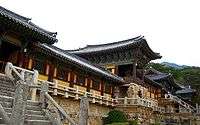Jinhan confederacy
| Jinhan confederacy | |
| Hangul | 진한 |
|---|---|
| Hanja | 辰韓 |
| Revised Romanization | Jinhan |
| McCune–Reischauer | Chinhan |
Jinhan was a loose confederacy of chiefdoms that existed from around the 1st century BC to the 4th century AD in the southern Korean Peninsula, to the east of the Nakdong River valley, Gyeongsang Province. Jinhan was one of the Samhan (or "Three Hans"), along with Byeonhan and Mahan. Apparently descending from the Jin state of southern Korea, Jinhan was absorbed by the later Silla, one of the Three Kingdoms of Korea.
History
Part of a series on the |
||||||||
|---|---|---|---|---|---|---|---|---|
| History of Korea | ||||||||
 | ||||||||
| Prehistory | ||||||||
| Ancient | ||||||||
| Proto–Three Kingdoms | ||||||||
| Three Kingdoms | ||||||||
|
||||||||
| North–South States | ||||||||
|
||||||||
| Later Three Kingdoms | ||||||||
|
||||||||
| Unitary dynastic period | ||||||||
|
||||||||
| Colonial period | ||||||||
|
||||||||
| Division of Korea | ||||||||
|
||||||||
| By topic | ||||||||
| Timeline | ||||||||
|
| ||||||||
Jinhan, like the other Samhan confederacies, arose out of the confusion and migration following the fall of Gojoseon in 108 BC.
Culture
Its relation to the earlier state of Jin is not clear, although the contemporary Chinese chronicle San Guo Zhi alleges that Jinhan was identical with Jin (while another record describes Jin as the predecessor of the Samhan as a whole). Jinhan and Byeonhan shared essentially the same culture, with varying religious customs, and apparently were not separated by a clear boundary.
The people claimed they were descendants of Qin dynasty migrants, fleeing Qin's force labor policies moved to the Mahan confederacy which give them the east land. The confederacy was also called Qinhan (秦韓). As immigrants, the kings might be Mahan people according to several historical books of China. [1][2]
The Samguk Sagi and Bei Shi say that the originally Lelang Commandery area which later became the area of Jinhan confederacy was the origin of Silla. [3][4][5][6][7]
Statelets
According to the San Guo Zhi, Jinhan consisted of 12 statelets of 600 to 5000 families each divided from 6 statelets:
- Saro (사로국, 斯盧國), most powerful state in Jinhan, it is also called Seorabeol. In 503, Saro state renamed itself "Silla".
- Gijeo (기저국, 己柢國), present-day Andong.
- Bulsa (불사국, 不斯國), present-day Changnyeong.
- Geun-gi (근기국, 勤耆國), present-day Pohang or Cheongdo.
- Nanmirimidong (난미리미동국, 難彌理彌凍國), present-day Miryang. It is also called "Mirimidong".
- Yeomhae (염해국, 冉奚國), present-day Ulsan.
- Gunmi (군미국, 軍彌國), present-day Sacheon.
- Yeodam (여담국, 如湛國), present-day Gunwi.
- Horo (호로국, 戶路國), present-day Sangju.
- Juseon (주선국, 州鮮國), present-day Gyeongsan.
- Mayeon (마연국, 馬延國), present-day Miryang.
- U-yu (우유국, 優由國), present-day Cheongdo or Yeongdeok.
According to Samguk Sagi, the Silla Kingdom (around present-day Gyeongju), was founded by Bak Hyeokgeose in 57 BC, who united the six clans of Jinhan under his rule. The records are sparse and conflicting regarding the relationship of the names Jinhan, Saro, Seorabeol, and the later Silla kingdom.
We know little of the daily life of Jinhan people. The religion appears to have been shamanistic, and to have played an important role in politics as well. Agriculture was heavily dominated by rice, but also included substantial rearing of livestock including horses, cattle, and chickens.
Location
Most theories indicate that Jinhan was located in the area later occupied by the Silla kingdom: the Gyeongju Basin and adjacent Sea of Japan coast. It would have been neighbored by the Byeonhan confederacy on the southwest, and by the much larger Mahan confederacy on the west. On the north it would have been bounded by the Chinese commanderies and the small coastal state of Dongye. However, some scholars place Jinhan in the Han River valley, bounded by Mahan on the north and Byeonhan on the south.
See also
References
- ↑ Samgungnyusa, Original: The History of the Later Han Dynasty writes, "An old person from Chenhan State said that some refugees came to Korea from the Chinese Empire of Qin, and Mahan gave them some land of her eastern border.
- ↑ Horesh, N. (2014). Asian Thought on China's Changing International Relations. Palgrave Macmillan. p. 175. ISBN 978-1137299321. "According to the Samguksagi entry for the 38th year of King Bak Hyeogeose of Silla, it is claimed that refugees from Qin settled in Jinhan, that is south-eastern Korea."
- ↑ Bei Shi列傳第八十二 四夷, Original: 新罗者,其先本辰韩种也。地在高丽东南,居汉时乐浪地。辰韩亦曰秦韩。相传言秦世亡人避役来适,马韩割其 东界居之,以秦人,故名之曰秦韩。其言语名物,有似中国人。....其文字、甲兵,同于中国Link
- ↑ Samguk Sagi新羅本紀/卷1/赫居世 居西干,Original:前此 中國之人 苦秦亂東來者衆 多處馬韓東 與辰韓雜居 至是寖盛 故馬韓忌之 有責焉 Link
- ↑ 朝鮮王朝 李圭景 五洲衍文长笺散稿 卷三十五 三韩始末辨证说,Link
- ↑ Gu Yanwu日知錄 卷29,Original:辰韩亦曰秦韩,相传言秦世亡人避役来适,马韩割其东界居之。以秦人故,名之曰秦韩。其言语名物有似中国人。Link
- ↑ Bei Shi 卷94 新羅,Original:相传言秦世亡人避役来适。Link